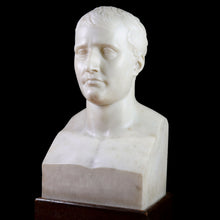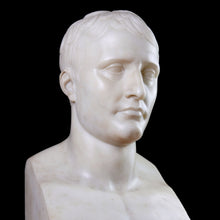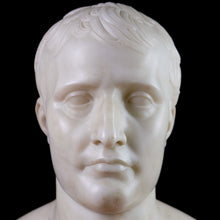Marble Bust of Napoleon after Chaudet
Adding product to your cart
Height of Marble bust: 59cm (23in)
Provenance: Colonel Thomas Blake-Humphrey (1844-1941) of Wroxham House, Norfolk, thence by descent.
The present bust of Napoleon I (1769-1821) derives from a model by the French sculptor Antoine-Denis Chaudet (1763-1810). Chaudet worked in a Neoclassical style and the 'herm' form of this bust, with the shoulders cut off and straight sides, imitates that of Roman imperial portraits. Raised on a 19th century wooden base (32cm high).
Read more
Chaudet made the original plaster model for this portrait in 1799. His final marble version of 1804 was Napoleon’s preferred image of himself. Moreover the Chaudet’s model became the official portrait of the newly crowned Emperor and was widely-reproduced, notably in hard porcelain at the Sèvres factory from 1805. Italy was under Napoleonic rule at this time and Napoleon presented his sister, Elisa Baciocchi, with the principality of Lucca and Massa-Carrara, an area which included the Apuan Alps from which Carrara marble was extracted. She ordered the Carrara workshops to carve multiple copies of Chaudet's bust and no less than 1,200 marble versions of this portrait were carved by the workshops between 1807 and 1809. This example is probably one of these official portraits, originally made for public buildings in France. The majority were destroyed when the Bourbon monarchy was restored in 1814.
Colonel Thomas Blake-Humphrey, JP, (1844-1941) purchased the present bust for the family seat Wroxham House, Norfolk. Thomas was the son of Captain Robert Blake (1795-1886) of Swalfield Hall, who as a seventeen year-old subaltern in Wellington’s Pensinsula army was ordered to take command of a company of the 57th (West Middlesex) Regiment of Foot at the passage of the Nive (13 November 1813). While doing duty with this company, Robert Blake was severely wounded in both legs by artillery fire. His left leg had to be amputated. He wrote in his diary: ‘I had strength and good spirits to bear up through the operations with cheerfulness and without flinching. Dr. Shekelton paid me compliment saying “It was like operating on a dead body”’. It was a story that was undoubtedly familiar to his son Thomas and his six siblings growing up and one that perhaps inspired him to enter the Army and in due course memorialise his father by acquiring the Napoleon bust. In 1847 Robert Blake inherited Wroxham House and all the estates in Norfolk and Suffolk belonging to his wife’s relative the Rev. John Humfrey, who requested him by his will ‘to take the name of Humfrey after and in addition to his own, and bear the arms of Humfrey quarterly with those of Blake’. This the one legged Peninsula veteran duly did and moved his family from Swafield Hall to Wroxham.










